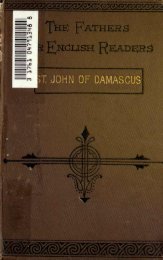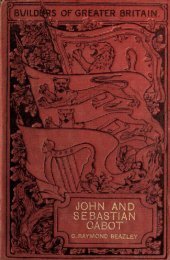Malayan literature; comprising romantic tales, epic poetry and royal ...
Malayan literature; comprising romantic tales, epic poetry and royal ...
Malayan literature; comprising romantic tales, epic poetry and royal ...
Create successful ePaper yourself
Turn your PDF publications into a flip-book with our unique Google optimized e-Paper software.
x«o MALAYAN LITERATURE<br />
He who received it was of the family of the c<strong>and</strong>idate for<br />
honors. With this piece they brought a tetampan scarf with<br />
which the reader invested the c<strong>and</strong>idate, whom he then introduced<br />
into the audience-chamber. There a mat was stretched<br />
for him to sit upon in whatever place the King designated.<br />
Then arrived the vestments. For a personage promoted<br />
to the ranks of the bendahari there were five trays. The sons<br />
of radjas <strong>and</strong> the gr<strong>and</strong> officers had four trays only, <strong>and</strong> so on<br />
down through the various ranks. The servitors of the King<br />
charged with this duty approached the beneficiary <strong>and</strong> placed<br />
the vestments upon his shoulders. He crossed his arms, to<br />
hold the vestments in place, <strong>and</strong> they took him outside. The<br />
etiquette in that was the same for ambassadors awarded an<br />
investiture, each according to the rights of his rank. The<br />
beneficiary dressed himself outside <strong>and</strong> then re-entered. They<br />
decorated him with a frontlet <strong>and</strong> with bracelets, for every<br />
man who received a title wore bracelets, each according to his<br />
dignity. Some had bracelets in the form of a dragon with<br />
amulets, others had bracelets of precious stones, others of blue<br />
enamel, others of silver. These wore them on both wrists, those<br />
on only one. The beneficiary thus decorated went <strong>and</strong> bowed<br />
before the King. Then he returned accompanied according to<br />
his rank, or by the person who introduced him. The cortege<br />
included now a drum <strong>and</strong> a flute alone, now trumpets or kettledrums,<br />
sometimes a white parasol ; but the white parasol was<br />
a rare honor, as well as the kettle-drums, for the yellow parasol<br />
<strong>and</strong> the trumpet were very hard to obtain in those times.<br />
On festival days, when the King went forth in a palanquin,<br />
he was surrounded by high officers of state. At the head,<br />
before the sovereign, marched the bataras <strong>and</strong> the houlou<br />
balongs, each following their charge. Footmen, also before<br />
the King, bore the <strong>royal</strong> insignia. The <strong>royal</strong> pikes were at the<br />
right <strong>and</strong> left; the bataras had sword at shoulder. Before<br />
them marched the lancers. When the King gives a festival it<br />
is the panghoulou bendahari who arranges everything inside the<br />
palace, stretches mats, decorates the balerong, <strong>and</strong> places the<br />
hangings on the ceilings.<br />
It is he who looks after the repasts<br />
<strong>and</strong> sends the invitations; for the servitors of the King, his<br />
bendahari, his tax-gatherers, <strong>and</strong> the receiver of the port all<br />
depend on the administration of the parighoulou bendahari.

















